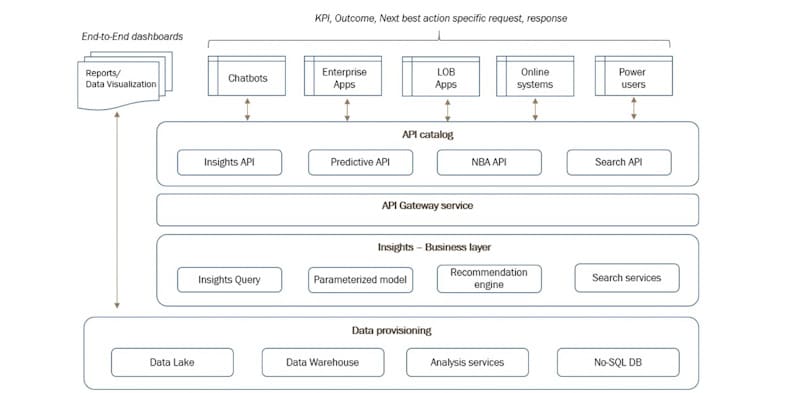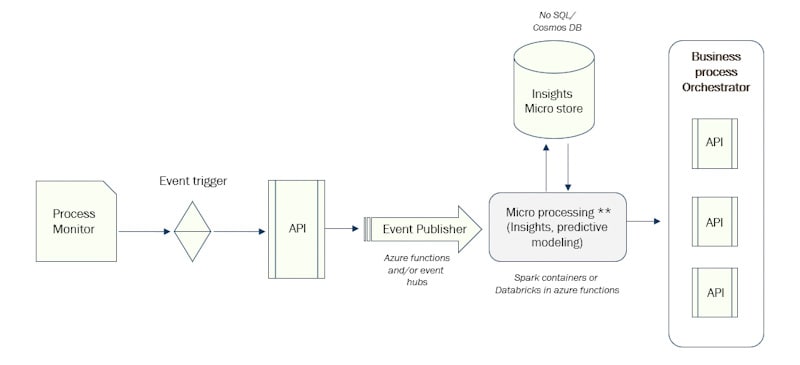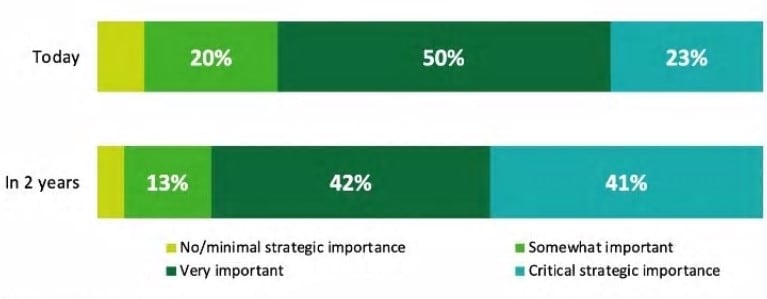With artificial intelligence being a hot technology topic and various investments being done to drive specific use-cases, it is important to thereafter transform holistically to an intelligent enterprise. This article discusses the approach needed for such transformations in which internal and external facing systems, machines and knowledge workers seamlessly make intelligent decisions on daily basis without having to access AI separately via specialized systems with long learning curves.
According to Deloitte’s 2020 survey of the 'State of AI in the enterprise', 90% of seasoned adopters say artificial intelligence (AI) is very or critically important to their organization's business success today.
From the survey, below is the depiction of the growing strategic importance of AI:
- Sixty-one percent of respondents say AI will substantially transform their industry in the next three years
- Adopters are making significant investments with 53% spending more than $20 million during the past year on AI and talent
Source: Deloitte Survey: State of AI in the Enterprise, Third Edition: Thriving in the Era of Pervasive AI
For transformation to an Intelligent enterprise, AI needs to be all pervasive
Without a doubt, AI is gaining traction. With the ongoing COVID-19 situation, adoption will increase with higher urgency. However, success with this intelligence will be critically dependent on how it is delivered. Systems need to be able to integrate this into daily lives of business workers rather than specialized apps that they need to learn about and access.
With this integration, AI planners need to be able to align value with the below recommended maturity curve.

Maturity of enterprises will go through phases of Aided, Augmented and Driven by AI. This will be influenced by the impact of partnerships AI solutions can have with human workers.
AI aided: These are solutions that are leveraged by human workers to do a better job. For example, availability of potential forecast can help humans with an alternate point of view to make capacity decisions that increase the likelihood of better margins.
AI augmented: These are solutions that work with humans to amplify their capability, ease challenges and help deliver better business results. Computer vision-based identification of anomalies in manufacturing process, tracking suspects via smart cameras are some examples of this. This is the emerging area as of today.
AI driven: The future however is in direction to free up human bandwidth to meet the potential of the human mind with a mix of empathy, creativity, cognitive intelligence and intuition. To aid this, AI solutions will need to be able to sense and drive the business. This will entail solutions not waiting for humans to initiate and explore them, rather they would be aware of when to intervene, what to intervene with and how to engage for human attention.
Caution on Pervasive AI
Before we proceed further, it is important to understand the caution required to mitigate the risks around data privacy and ethics in leveraging AI. Relevant best practices need to be put in place to avoid data leaks and ensuring bias does not creep into the algorithmic outcomes. As with any technology, it is impactful if it is leveraged in the right manner.
Approach for delivering Intelligent enterprise
Creating such pervasive intelligence will need following approaches:
- Experience of leveraging intelligence has to be seamless and well-integrated almost in ways app stores and play stores consumerize applications. For example, manufacturing operation users should be able to install and leverage connected apps that provide insights on quality issues, upcoming interventions needed.
- Intelligence needs to be embedded within enterprise applications which deliver this value within the business process workflows. For example, customer service representatives should receive next best action recommendations within their service management systems while speaking to customers.
- AI cores need to detect events in real-time that need intervention and be able to partner and drive business workers to deliver responses that leverage AI investments. For example, supply chain systems can auto adjust forecasts and inventory levels based on evolving demand. Computer vision-based solutions can initiate security interventions and product defect investigations
Intelligent enterprise—architectural patterns
Below are some of the architectural patterns that will help deliver pervasive AI impactfully in the enterprise. There is a need for data engineers to look beyond data lakes and focus on delivering the intelligence just in time and on the channel where decisions are being made. In addition, natural human interfaces will play a key role in AI being truly pervasive.
Pattern 1: API driven embedded intelligence
Below is an illustrative pattern of leveraging APIs to deliver AI. Provisioned data and analytical models are democratized via various mutations of APIs that deliver insights, predictive recommendations, next best actions and information searches.
This helps in rolling out and embedding knowledge from few centralized centers of excellence and programs to a gamified approach where intelligence will be innovatively leveraged by various application development communities in an organization.

Pattern 2: Event driven insights
Below pattern enables data to drive business processes and respond to situations intelligently. Specific situations lead to an event being published which in turn initiates micro processing of insights leading to next best actions via orchestrated API calls.

Pattern 3: Computer vision driven manufacturing anomaly detection
Below is an example of embedding intelligence in devices to enable next generation of AI led process optimizations. This example uses computer vision solution via cameras to help improve wafer yield during the semiconductor manufacturing process through reduction in scrap and usage of test wafers.

The solution has an instant inference engine on the edge for real time alerting and a self-evolving brain enabled by seamless scalability on a modern cloud platform, democratized intelligence for rapid investigations. This has a multi-line, multi-location based global command center approach to monitor and control manufacturing quality and yield centrally.
Conclusion
It is important for businesses to transform to an intelligent enterprise with high sense of urgency. Time for investments to step up this maturity is apt and appropriate frameworks and architectural patterns need to be established for gamification and democratization of AI in the enterprise.
Key Contacts

Arunabha Mookerjea
Arunabha Mookerjea is a specialist leader and distinguished cloud architect in the Strategy and Analytics practice at Deloitte Consulting India Private Limited. He specializes in technology advisory, solution architectures and directing large scale delivery in next generation areas of cloud and big data platforms, IoT, micro-services and digital core solutions. Arunabha is a member of the Next Gen Architecture Program.
